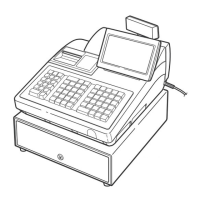CONTENTS
Parts marked with "!" are important for maintaining the safety of the set. Be sure to replace these parts with specified
ones for maintaining the safety and performance of the set.
This document has been published to be used
for after sales service only.
The contents are subject to change without notice.
PROGRAMMING MANUA
CODE : 00Z
N LEAD-FREE SOLDER0 - 2
CHAPTER 1. TOUCH PANEL CALIBRATION,
MASTER RESET AND PROGRAM RESET1 -
1
CHAPTER 2. READING OF SRV MODE PRO-
GRAM 2 - 1
CHAPTER 3. SRV MODE PROGRAMMING
(“SETTING”) 3 - 1
CHAPTER 4. SRV MODE PROGRAMMING
(“IRC SETTING”)4 - 1
CHAPTER 5. SRV MODE PROGRAMMING
(“DOWN LOAD”)5 - 1
CHAPTER 6. SRV MODE PROGRAMMING
(“SD CARD MODE”)6 - 1
LEAD-FREE SOLDER MODEL
UP820FUPME
POS TERMINAL
UP-810F
UP-820N
MODEL UP-820F
(For “U” version)
<UP-820N>
<UP-810F>
<UP-820F>
LEAD-FREE SOLDER
MAJOR KEYS USED IN THE SRV MODE
CHAPTER 1. TOUCH PANEL CALIBRATION, MASTER RESET
AND PROGRAM RESET . . . . . . . . . . . . . . . . . . . . . 1 - 1
CHAPTER 2. READING OF SRV MODE PROGRAM . . . . . . . . . . 2 - 1
CHAPTER 3. SRV MODE PROGRAMMING (“SETTING”) . . . . . . 3 - 1
CHAPTER 4. SRV MODE PROGRAMMING
(“IRC SET UP”) . . . . . . . . . . . . . . . . . . . . . . . . . . . . 4 - 1
CHAPTER 5. SRV MODE PROGRAMMING
(“DOWN LOAD”) . . . . . . . . . . . . . . . . . . . . . . . . . . 5 - 1
CHAPTER 6. SRV MODE PROGRAMMING
(“SD CARD MODE”)
. . . . . . . . . . . . . . . . . . . . . . . . . 6 - 1

